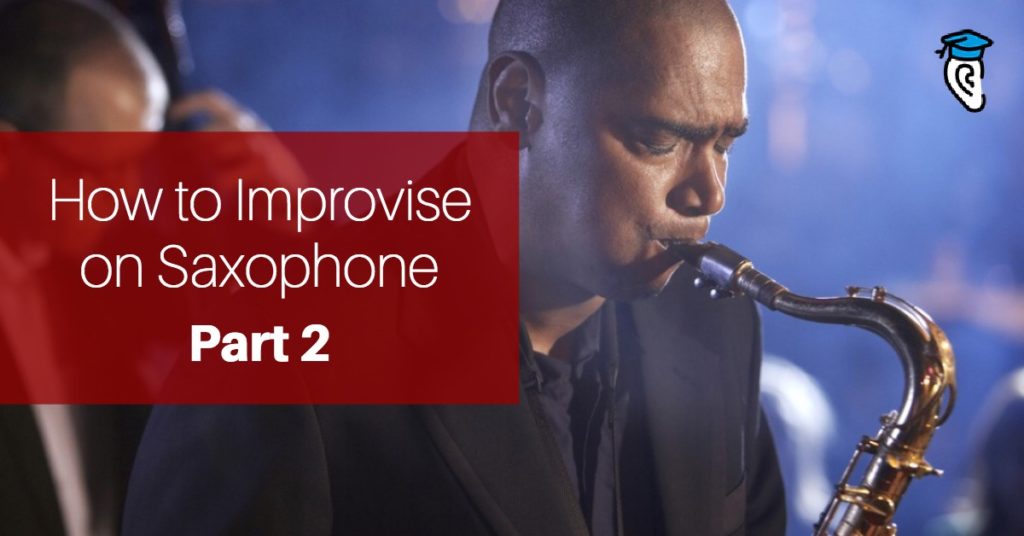Want to improvise on saxophone? In this tutorial you’ll learn how, step by easy step. In Part One we covered the basic concepts of improvisation and in Improvising in different styles: Jazz we covered some of the things which make jazz soloing different to improvising in other genres. Now it’s time to look at the specifics of how you can learn to improvise jazz music on saxophone.
Jazz Saxophone Improvisation
Once you can improvise on blues, it’s time to try improvising jazz. You can do this without getting lost by simply building on your blues skills and applying them to the most popular (or your own favourite) jazz standards.
Look up the lead sheet to see the chord changes. This will help you learn to follow more complex chord changes than the I-IV-V progressions of blues without needing to recognise them all by ear just yet. Like before, start by simply playing the arpeggio of each chord during its bar. Then try adding in some other notes.
What scale should you use? Here’s a handy tip from Julian Bradley in our recent jazz improvisation ear training experts guide:
A good rule of thumb when choosing which scales to play from is this: build your scale using the chord’s root, 3rd, 5th and 7th. For example, for C minor 7 you’d start with C E♭ G B♭. Then add a whole-step above the root, 3rd and 5th – in this case, you’d get D F A, which means you’d be playing C dorian scale (C D Eb F G A B♭). C dorian sounds consonant played over C minor 7, and this process works for any chord.
After getting the chord changes into your head, take time to listen to some of your favorite saxophone players improvising on that standard. Use the excellent LearnJazzStandards.com to find recordings. You can even try to transcribe their recordings by ear and use them as the basis for your own soloing. This is an early step towards finding your own distinctive improvisation style and defining “your sound”.
For an extra challenge, transcribe a cool lick you found or created in one of the standards and try to learn it in all 12 keys. It’s a slightly hardcore exercise but it pushes your limits and starts to really free up your playing by internalising the sounds of the scale degrees more and more.
Here are two great resources as you practice by transcribing jazz saxophone solos:
As well as the more complex chord progressions and scales used, a large part of what distinguishes jazz improvisation is the effective use of rhythm.
Experiment with rhythm
Each time you play a solo, challenge yourself to be innovative with your rhythm. Experiment with different note durations. Adding (or removing) syncopation on individual notes and the overall swung beat.
Want a great rhythm exercise? Try soloing with just two notes, as recommended by Chris Cooke and Willie Thomas in our jazz ear training experts guide. See how interesting can you make your solo if you remove all the note choices you’re normally overwhelmed by and instead focus almost entirely on the rhythm. And then see how different can you make each new solo on the same song. As Miles Davis put it, “Don’t worry about playing a lot of notes. Just find one pretty one.”
Speed it up – and give it space
As you develop your own jazz sound, work some time into your training routine to try and speed up your skills. Try increasing your tempo gradually and see where it takes you. Playing faster is not just a show of technical expertise: remember it is the level of creativity that counts in improvisation and sometimes a faster tempo brings out new ideas or strips away dead weight from your solo.
Particularly at fast tempos, make sure not to fill every beat with notes!
Give your rhythm section some time to give you feedback. Give your audience some time to digest your last idea.
Trust Your Ears
In improvisation and particularly in jazz it’s all too easy to get lost in the theory and the scales and the patterns and the changes. Many jazzists give up too early because they feel overwhelmed and intimidated.
So here’s one simple trick to ensure you succeed: trust your ears.
Use the theory and tools and frameworks to help you explore the possibilities but remember that ultimately it’s what sounds good that matters.
Only your ears can tell you if your solo is good or not and only your ears can define your jazz sax style.
So work on your ear training, learn to audiate and then bring the solos in your head out into the world through your sax.
Go Beyond
Trusting your ears will lead you to the ultimate goal in saxophone improvisation: total freedom. Having worked through the basic exercises, learned the blues fundamentals and explored more advanced jazz improv, as long as you trust your ears you will increasingly feel free and able to play whatever you dream of.
As a saxophone improviser, you should be able to develop original musical lines that not only fit the chords and style of music but also show melodic innovation, interesting shape and expression, and leave the listener wowed – not by your technical chops but by your musicality and the journey you were able to take them on through listening to your performance.
So learn the rules and then go beyond them. Integrate improvisation practice into all the repertoire you memorise, all the theory you learn and all the ear training you do. And before you know it saxophone improvisation will just be a natural part of who you are as a musician. Good luck – and have fun with it!


 Click to tweet
Click to tweet




